
Educating pupils about sustainability poses several challenges, especially in keeping their attention and making the subject relatable. One major obstacle is that sustainability often deals with abstract or large-scale concepts like climate change, deforestation, or global pollution, which can feel distant or overwhelming to young minds. It requires breaking down these big ideas into smaller, more tangible lessons that kids can connect to their everyday lives.
Moreover, the digital distractions many children face can make it difficult to engage them in topics that may not seem immediately exciting. Competing with social media, games, and other forms of entertainment requires creative teaching strategies that make learning feel less like a chore and more like an adventure.
In some cases, pupils may come from environments where sustainability isn’t prioritized at home, making it harder for them to grasp the importance of these efforts. Teachers must find ways to encourage changes in behavior, not just in the classroom but also at home, and they must communicate the importance of sustainability in ways that resonate with students of all backgrounds.
Finally, sustainability education requires constant updates and innovation as environmental challenges evolve. Teachers need to stay informed and incorporate new trends or solutions in the field, adapting their approach regularly to ensure that the material stays relevant and actionable.
Why are Playful Learning Methods better?
Incorporating playful methods into sustainability education provides a more dynamic, engaging, and effective way to teach young pupils, helping them internalize critical environmental lessons while having fun.
Here’s why these methods work better:
- Increased Engagement: Playful methods capture attention by making learning enjoyable. When lessons are fun, students are more likely to stay focused and participate actively.
- Enhanced Creativity: Play stimulates imagination. It encourages students to think creatively, helping them develop problem-solving skills. In sustainability education, creative thinking is crucial for understanding how to address environmental challenges.
- Deeper Retention: Hands-on activities, games, and role-playing improve memory retention. When students experience concepts through play, they are more likely to remember them compared to traditional lecture-based methods.
- Social and Emotional Development: Playful learning fosters collaboration and communication, allowing children to work together. These social interactions help develop empathy, an essential component in understanding sustainability’s impact on others and the environment.
- Natural Curiosity: Children are naturally curious, and playful learning taps into this by encouraging exploration and experimentation. This curiosity-driven approach helps students independently seek answers and explore sustainability topics more deeply.
- Lower Pressure: Traditional education methods can sometimes create anxiety or boredom, particularly for younger pupils. Playful learning reduces pressure, creating a stress-free environment where children feel more comfortable to explore new ideas.
Playful Learning Methods to Engage Young Students in Sustainability
Here are several strategies that teachers can use:
- Interactive Games and Simulations: Create or use existing games that focus on sustainability topics. For example, simulate an ecosystem where pupils need to manage resources like water, energy, and food sustainably, or play board games about recycling or environmental conservation.
- Outdoor Learning: Take students outside for hands-on activities like planting trees, maintaining a garden, or cleaning up local parks. Learning about biodiversity, recycling, and the importance of nature becomes more tangible when experienced in the environment itself.
- Creative Projects: Encourage students to design posters, infographics, or small models showing ways to conserve resources. They could build their own solar ovens, wind turbines, or water filtration systems.
- Storytelling and Role Play: Use stories about environmental heroes or scenarios where students take on roles of decision-makers, like mayors or farmers, tasked with sustainable management of their town or farm. This fosters empathy and problem-solving.
- Art and Crafts with Recycled Materials: Organize activities where students create art or functional items out of recycled materials. This shows them the value of reusing products and sparks creativity.
- Eco Challenges: Set up weekly or monthly sustainability challenges in the classroom, like reducing energy usage, minimizing plastic waste, or bringing zero-waste lunches. Create friendly competitions to motivate participation.
- Use Digital Tools: Introduce students to apps and platforms focused on environmental education, such as carbon footprint calculators or virtual reality experiences that explore endangered ecosystems.
- Sustainable Science Experiments: Conduct fun experiments like growing plants with different types of water (e.g., rainwater vs. tap water), composting food waste, or creating a small DIY water cycle system.
The Power lies in the Hands of Teachers
Despite the challenges, the power to foster a generation that cares for the planet lies in the hands of educators. By introducing sustainability through playful, creative methods, teachers can inspire curiosity, empathy, and a sense of responsibility in their pupils. When sustainability becomes a part of their everyday thinking, children can grow into adults who actively contribute to a healthier, more balanced world. Teaching sustainability isn’t just about information; it’s about nurturing the mindset that will drive positive change.
